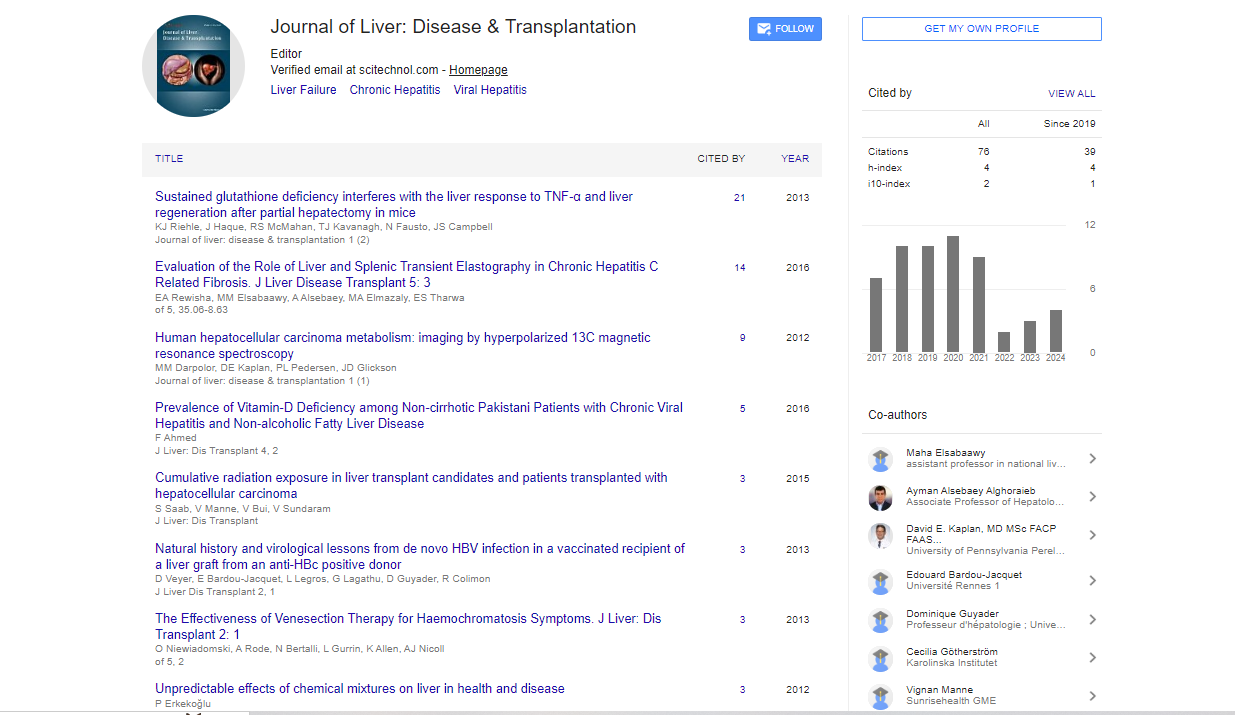Opinion Article, J Liver Disease Transplant Vol: 13 Issue: 4
Epidemiology of Alcohol-Associated Liver Disease: Trends and Implications for Public Health
Tao Xie*
1Department of Gastroenterology and Hepatology, Shanghai Institute of Digestive Disease, Shanghai, China
*Corresponding Author: Tao Xie,
Department of Gastroenterology and
Hepatology, Shanghai Institute of Digestive Disease, Shanghai, China
E-mail: 546638388791@163.com
Received date: 28 November, 2024 Manuscript No. JLDT-24-156890;
Editor assigned date: 02 December, 2024, PreQC No. JLDT-24-156890 (PQ);
Reviewed date: 16 December, 2024, QC No. JLDT-24-156890;
Revised date: 23 December, 2024, Manuscript No. JLDT-24-156890 (R);
Published date: 30 December, 2024, DOI: 10.4172/2325-9612.1000290.
Citation: Xie T (2024) Epidemiology of Alcohol- Associated Liver Disease: Trends and Implications for Public Health. J Liver Disease Transplant 13:4.
Abstract
Description
Alcohol-Associated Liver Disease (ALD) remains a major public health concern, particularly as the global prevalence of alcohol consumption continues to rise. The spectrum of ALD includes conditions such as simple steatosis (fatty liver), alcoholic hepatitis and cirrhosis, with cirrhosis being one of the leading causes of liver-related mortality worldwide. The World Health Organization (WHO) estimates that over 3 million deaths annually are attributable to harmful alcohol use, with liver disease accounting for a significant proportion of these deaths. ALD places a substantial burden on healthcare systems due to its chronic nature, complexity and the limited treatment options available once the disease progresses to advanced stages. The increase in alcohol consumption is largely attributed to economic, cultural and social factors. In regions such as East and Southeast Asia, Latin America and Eastern Europe, alcohol consumption rates have risen rapidly due to changing cultural norms and increased urbanization. In these areas, alcohol is often consumed at higher quantities and with greater frequency, contributing to a rise in alcohol-related liver diseases. Socioeconomic disparities further exacerbate the burden, with individuals of lower socioeconomic status more likely to engage in harmful drinking patterns and less likely to have access to healthcare services that could prevent or manage ALD.
A key factor driving the increasing prevalence of ALD is the metabolic effects of alcohol on the liver. Alcohol consumption leads to the accumulation of toxic metabolites, such as acetaldehyde, which damages liver cells and impairs liver function. In individuals with prolonged or heavy alcohol use, the liver becomes increasingly susceptible to fibrosis, cirrhosis and eventually liver failure. Fatty liver disease, a mild form of ALD, can progress asymptomatically but often progresses silently until complications arise, further contributing to the overall burden of ALD. Additionally, the demographic patterns of ALD highlight significant at-risk populations. Studies shows that males are more likely than females to develop ALD, which may be linked to higher levels of alcohol consumption among men. Younger age groups are also increasingly affected, particularly as binge drinking becomes more prevalent among adolescents and young adults. Ethnic and genetic predispositions also play a role, with certain populations exhibiting higher susceptibility to alcohol-induced liver damage. For example, studies indicate that individuals of East Asian descent have a lower alcohol dehydrogenase activity, leading to higher acetaldehyde concentrations and increased liver damage from alcohol consumption. Geographic variations in ALD prevalence further highlight the disease's public health impact. Countries with high rates of alcohol consumption, limited access to healthcare and higher levels of poverty report higher prevalence rates of ALD. For instance, countries in Eastern Europe, such as Russia and Ukraine, have some of the highest rates of cirrhosis and liver cancer due to high alcohol consumption and limited healthcare infrastructure. In contrast, countries with lower alcohol consumption levels tend to report lower rates of ALD but still face challenges related to alcohol-related liver disease due to urbanization, industrialization and globalization.
The implications of rising ALD prevalence extend beyond individual health outcomes. ALD contributes to significant economic burdens, including increased healthcare costs related to hospitalization, liver transplants and long-term care for cirrhosis and liver cancer. Moreover, the societal impact of ALD includes loss of productivity due to premature deaths, disability and increased rates of absenteeism. The economic and social costs of ALD strain healthcare systems, particularly in countries with limited resources and underdeveloped public health infrastructure. Preventing and managing ALD requires a comprehensive public health approach. Policies aimed at reducing alcohol consumption, such as taxation, limiting alcohol availability and regulating alcohol advertising, have been shown to be effective in reducing alcohol-related harms. Public awareness campaigns emphasizing the risks of alcohol consumption and promoting healthier lifestyle choices are important components of prevention strategies. Early identification of individuals at risk through screening programs, particularly those with signs of heavy drinking, is essential for preventing progression to more severe forms of liver disease. Treatment options for ALD remain limited, especially in the advanced stages. Abstinence from alcohol remains the most effective intervention to halt disease progression, but many individuals may struggle to achieve and maintain sobriety. Medical interventions such as nutritional support, corticosteroids and anti-fibrotic therapies may slow disease progression in some cases, but they are not universally effective. Liver transplantation offers the only potential cure for patients with end-stage ALD, but access to transplants remains limited due to organ shortages and the high costs associated with the procedure.
Conclusion
The rising prevalence of ALD poses significant public health challenges, driven by increasing alcohol consumption, demographic shifts and socioeconomic factors. ALD not only impacts individuals’ health but also places a substantial strain on healthcare systems and economic resources. Addressing this issue requires a multi-pronged approach that includes prevention, early intervention, public awareness and improved access to healthcare services. By reducing harmful alcohol consumption and enhancing healthcare responses, public health strategies can help reduce the burden of alcoholassociated liver disease, improving both individual and populationlevel outcomes.
 Spanish
Spanish  Chinese
Chinese  Russian
Russian  German
German  French
French  Japanese
Japanese  Portuguese
Portuguese  Hindi
Hindi 